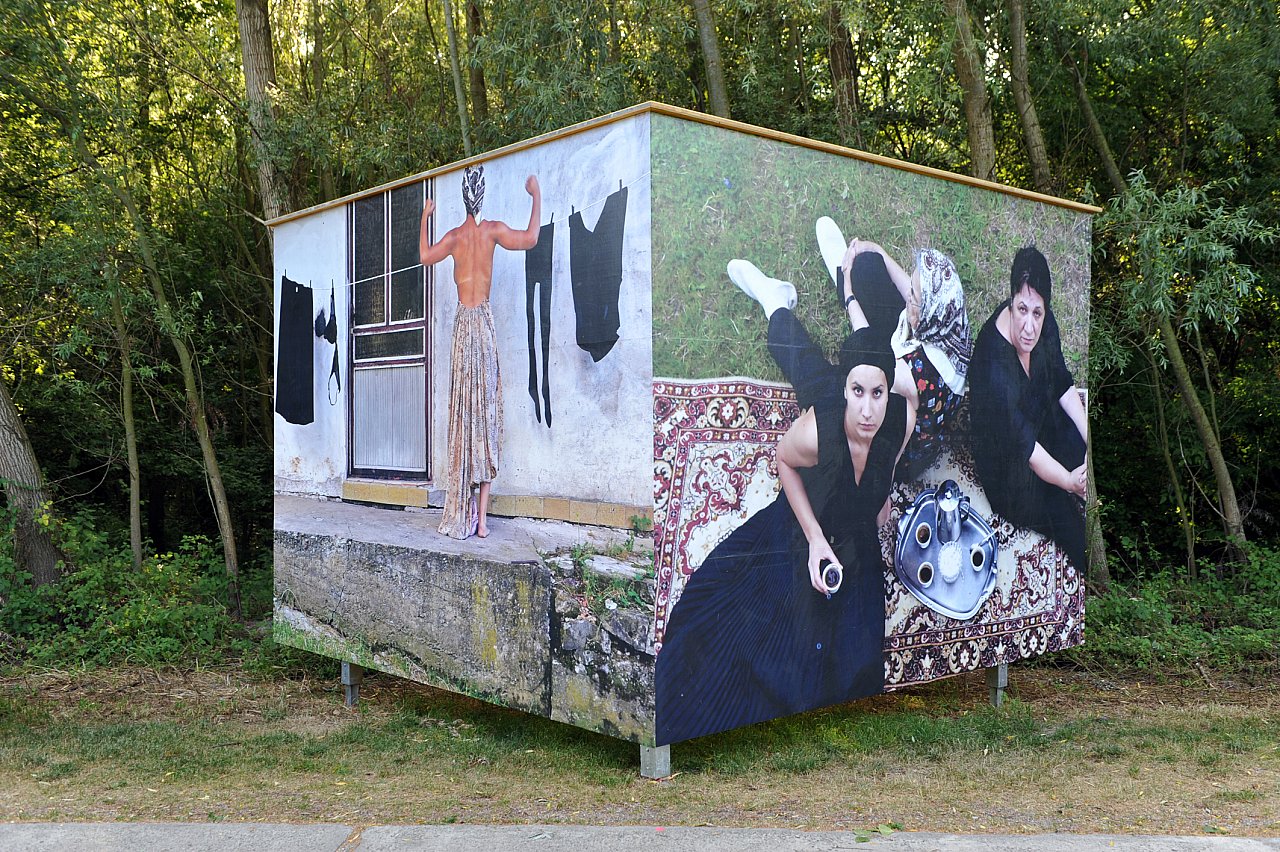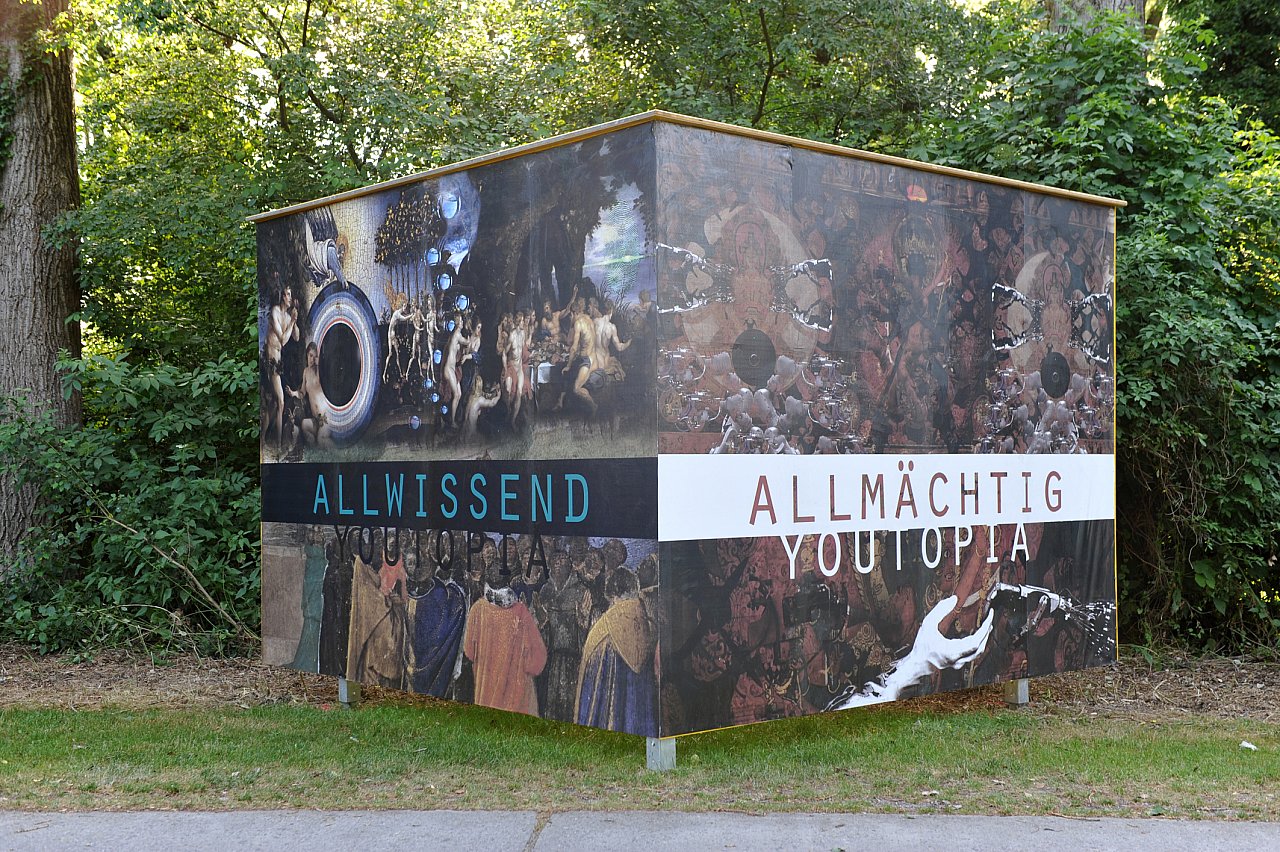Du oder ich? Collective Soul. Ethik des Miteinanders
A temporary exhibition project in the public space of Melk in cooperation with the Department of Art and Culture of the Province of Lower Austria / public art, the Friends of the Melk Festival and the Town of Melk as well as Melk Abbey in cooperation with KulturKontakt Austria / BKA and Fluc as well as the Vienna Academy of Fine Art Department of Art
with Extended Pictorial Spatial Action / Sculpture / Installation in Public Space (director Judith Huemer).
2017 June 16 to August 20
Artists: Giovanna Graziosi Casimiro, Ðejmi Hadorvić, Lina Albrikienė, Dante Buu, Olson Lamaj, Female Obsession, Libidiunga Cardoso & Caetano Carvalho & MARSSARES, Kadija de Paula & Chico Togni, TEAM OLYMP, Taro Meissner, Cäcilia Brown/Marc Alexandre Dumoulin/Baptiste El Baz
Performances: Libidiunga Cardoso, Jianan Que, Daniel Lie
Curated by Ursula Maria Probst
Produced by Martina Fürst
Our current political dynamic is fueling populism, and not even so-called facts tell the truth anymore. In the current discussions about fake news, calls to question alternative facts are getting louder. Social media, big data, and echo chambers structure the spaces of the real. What happens if identity politics are taken over by identitarian politics? What remains unsaid, and what must be clarified when we talk about integration processes in the face of current global migration, when we should actually be talking about accepting plurality?
Who do we address when we talk about the other – i.e., when we talk about all the “yous”? Despite all the talking, nothing is really being said. The starting point for the broadly focused art project Du oder ich? Collective Soul. Ethik des Miteinanders (You or Me? Collective Soul. The Ethics of Togetherness), which includes international artists (with a focus on Brazil), was the idea to create a historical context for the fantastic spectacle that is our current political situation. Another issue is the political distinction between you/me and we/them, along with the attempt to separate the actors of history from those affected by it. What demands do we make on art and culture today in their work with identity, visibility, and narratability in this context? What is our understanding of self-determination and mutual support through shared experiences? How do we approach our multi-temporal day and age and the current political spectacle? We are permanently confronted with information that aims to strike a chord with us.
Experiences of past abuses of power, violence, and religious conflicts fade from memory, while the use of digital media and quick access to information seems to make working with remembrance obsolete. In 2017, the 500th anniversary of Luther’s nailing his Theses to the door of the church in Wittenberg was celebrated as the starting point for a religious conflict that lasted for many centuries. At the Sommerspiele (Summer Festival) in Melk, this anniversary was an occasion to restage the Massacre of St. Bartholomew’s Day and address a highly controversial issue that still faces us today, albeit under different circumstances. Let us briefly review the historical event: In Paris 1572, the magnificent wedding of Marguerite de Valois, a Catholic, to King Henry of Navarra, a Protestant, had been organized under the premise of a reconciliation between the two churches. The celebration turned out to be a trap, however, and a blood wedding ensued in which thousands of people were massacred.
with Extended Pictorial Spatial Action / Sculpture / Installation in Public Space (director Judith Huemer).
2017 June 16 to August 20
Artists: Giovanna Graziosi Casimiro, Ðejmi Hadorvić, Lina Albrikienė, Dante Buu, Olson Lamaj, Female Obsession, Libidiunga Cardoso & Caetano Carvalho & MARSSARES, Kadija de Paula & Chico Togni, TEAM OLYMP, Taro Meissner, Cäcilia Brown/Marc Alexandre Dumoulin/Baptiste El Baz
Performances: Libidiunga Cardoso, Jianan Que, Daniel Lie
Curated by Ursula Maria Probst
Produced by Martina Fürst
Our current political dynamic is fueling populism, and not even so-called facts tell the truth anymore. In the current discussions about fake news, calls to question alternative facts are getting louder. Social media, big data, and echo chambers structure the spaces of the real. What happens if identity politics are taken over by identitarian politics? What remains unsaid, and what must be clarified when we talk about integration processes in the face of current global migration, when we should actually be talking about accepting plurality?
Who do we address when we talk about the other – i.e., when we talk about all the “yous”? Despite all the talking, nothing is really being said. The starting point for the broadly focused art project Du oder ich? Collective Soul. Ethik des Miteinanders (You or Me? Collective Soul. The Ethics of Togetherness), which includes international artists (with a focus on Brazil), was the idea to create a historical context for the fantastic spectacle that is our current political situation. Another issue is the political distinction between you/me and we/them, along with the attempt to separate the actors of history from those affected by it. What demands do we make on art and culture today in their work with identity, visibility, and narratability in this context? What is our understanding of self-determination and mutual support through shared experiences? How do we approach our multi-temporal day and age and the current political spectacle? We are permanently confronted with information that aims to strike a chord with us.
Experiences of past abuses of power, violence, and religious conflicts fade from memory, while the use of digital media and quick access to information seems to make working with remembrance obsolete. In 2017, the 500th anniversary of Luther’s nailing his Theses to the door of the church in Wittenberg was celebrated as the starting point for a religious conflict that lasted for many centuries. At the Sommerspiele (Summer Festival) in Melk, this anniversary was an occasion to restage the Massacre of St. Bartholomew’s Day and address a highly controversial issue that still faces us today, albeit under different circumstances. Let us briefly review the historical event: In Paris 1572, the magnificent wedding of Marguerite de Valois, a Catholic, to King Henry of Navarra, a Protestant, had been organized under the premise of a reconciliation between the two churches. The celebration turned out to be a trap, however, and a blood wedding ensued in which thousands of people were massacred.
In the context of an art project, the question is how aesthetic developments can be negotiated in the context of political change. We are now confronted with nationalist and xenophobic developments in Europe that are being countered by artistic and cultural projects that explore the different forms of movement, policies of migration, and borders between cultural territories, people, and the flow of data. As the frequency of breaking news increases, insecurity and chaos are growing, while terms are changing and shifting in meaning as a result of this current acceleration. There is a growing longing for less emotional reflection and analysis. Can we communicate with people who have a different point of view than ourselves, and if yes, how much?
Melk Abbey, where this project took place, is regarded as one of Europe’s spiritual centers. The city of Melk and the neighboring area are highly characterized by church architecture. As a World Cultural Heritage site that cultivates an image of open-mindedness, Melk Abbey is a monumental architectural product of the Counter-Reformation and its struggle for power, while also during that time, Schallaburg became a Protestant center, and the town of Loosdorf and the Wachau region, both close by, also showed Protestant tendencies and historic ambitions for independence and freedom.
How can signs of respect and humanism be articulated? How can a network be created through artistic works and interventions?

Youtopia
Giovanna Graziosi Casimiro
Youtopia questions the concept of a utopia in a time of high technology and the awareness of the limits of the human body. An omnipresent cyber culture is replacing faith in a god, in life after
death. In an analogy between technology and religion, Apple to Oracle will have us believe in their omniscience, omnipotence and omnipresence.
Through numerous surveillance mechanisms this new god keeps his eye on us without us noticing. There are no races, no genders, no more prejudices, because the new god sees everyone as a small part of a machine, an enormous collection of data. The soul becomes the measured value and the new god waits for the next click.

Melk Abbey, where this project took place, is regarded as one of Europe’s spiritual centers. The city of Melk and the neighboring area are highly characterized by church architecture. As a World Cultural Heritage site that cultivates an image of open-mindedness, Melk Abbey is a monumental architectural product of the Counter-Reformation and its struggle for power, while also during that time, Schallaburg became a Protestant center, and the town of Loosdorf and the Wachau region, both close by, also showed Protestant tendencies and historic ambitions for independence and freedom.
How can signs of respect and humanism be articulated? How can a network be created through artistic works and interventions?

Youtopia
Giovanna Graziosi Casimiro
Youtopia questions the concept of a utopia in a time of high technology and the awareness of the limits of the human body. An omnipresent cyber culture is replacing faith in a god, in life after
death. In an analogy between technology and religion, Apple to Oracle will have us believe in their omniscience, omnipotence and omnipresence.
Through numerous surveillance mechanisms this new god keeps his eye on us without us noticing. There are no races, no genders, no more prejudices, because the new god sees everyone as a small part of a machine, an enormous collection of data. The soul becomes the measured value and the new god waits for the next click.


